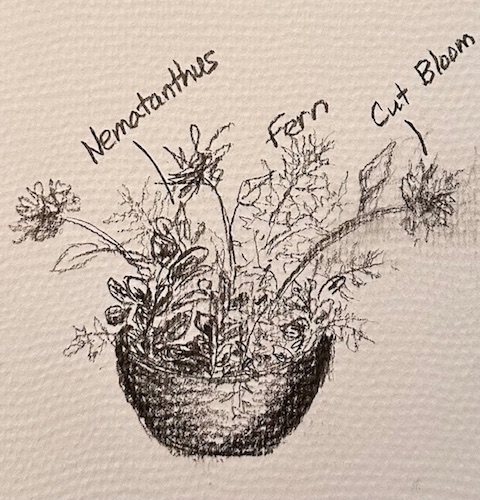Pot-et-Fleur
I love mixing houseplants with cut flowers to create a single display. But until recently, I did not know this way of arranging had a name: pot-et-fleur. Somehow, now that I can attach a name to a practice I have loved for so long, it seems ever more legitimate to situate groupings of cut flowers amid the foliage of lush, growing houseplants that last and last.
Pot-et-fleur is one of several approaches to balancing out a small number of long-stemmed cut beauties with other material to add fullness to a floral display. Think back to florists’ use of Carnations. There would be questions from buyers: “Tell me the truth, will it be all Carnations? How many Roses will there be?” Easy and economical for florists to obtain, the Carnations sort of “faked the look” of a full arrangement. But Carnations are pretty in their own right, not “fakers” at all.
Serving a similar purpose, potted houseplants can provide structure underneath a lighter, sparser array of cut flowers. These potted plants play a key role, not just that of filler. They add color and texture by way of their lush greenery.
Some of the healthiest looking greenery I know is offered by Nematanthus, the Goldfish Plant. A plant with fish-shaped blooms is pretty whimsical. But whimsy aside, Nematanthus has foliage which maintains an amazing shine and strength. The sturdy form and fullness of Nematanthus would work beautifully as part of a pot-et-fleur display.
Now, I love everything about cut flowers, even their fragility. But I cannot afford as many as I would like. I can create nice arrangements, but they are smaller than I would like them to be. Nematanthus and other potted living plants can expand the size of my arrangements with their dense growth. In addition, these potted plants are arguably a better investment, with greater staying power. They stick around in the form of healthy houseplants long after a bigger display is disassembled, wilted cut flowers regretfully discarded.
Those who create pot-et-fleur arrangements are not always—in fact, not typically—just thinking about economics. They are aiming to produce something that looks grand, or looks as though it is a slice of nature captured at the perfect time and brought indoors. They pair up different varieties of plants (say, Nematanthus and Fern or Tradescandia and Fern) that look great together, and then they add pops of color in the form of cut flowers. They build tabletop vignettes that combine form, texture, color… vignettes that can be changed up with creative switch-outs of cut blooms from time to time.
Pot-et-fleur translates from French to English as pot-and-flower. To create a pot-et-fleur arrangement, use a large vessel—grand bowl, tiered planter, or another special container—and first drop in your potted plants, newly moistened and in their original plastic plant pots. You will not be adding soil directly to the large vessel in which everything will be situated, so you have flexibility. The odds of damaging the vessel are slim.
Build a base structure with your potted plants, being sure to leave gaps where small cut-flower bouquets can fit and fill. These gaps will appear naturally: Plastic plant containers will not fit side-by-side perfectly to fill space, so there will be natural holes in your design… useful ones, in this case.
Once your structure is set—picture mounds of Nematanthus and some Maidenhair Fern for a different texture—you will add your cut flowers. Depending on the size of the gaps that remain, you can add these blooms in tiny vases… even plastic cups. Steady them within your larger container, being sure they will not tip. To fill smaller gaps, you may need floral water tubes which can be bought online. These tubes take up even less space. Simply ensure all the cut flowers stay in water. (You could never fill your main vessel with water, as the houseplants would become waterlogged. So find ways to insert tiny water containers to satisfy the needs of your flower stems. “Sprinkle them” here and there around your display, covering up all plastic and structural bits by positioning and repositioning the foliage of your potted plants.)

Now, a pot-et-fleur display will stay beautiful for a long time. Eventually, you will need to switch out your cut flowers. However, this is a benefit: For example, you can turn an autumnal display (Nematanthus and tallest Chrysanthemum stems) into a winter beauty (Nematanthus and stems of Amaryllis).
Knowing how to name pot-et-fleur and digging into it as a topic make me appreciate this display-building practice more and more. I tended to create this sort of mixed arrangement mainly as a cost-saving measure. Now I see the enchanting displays that can be made with the right potted plants, the right cut flowers… arrangements that are more beautiful than most, simply due to the “et” (“and”)—simply due to the mixing.
So, mix it up! Try this technique, grouping together little treasures, both cut and growing, to create a masterpiece.
Comments
{{ errors.first("comment") }}